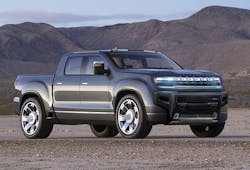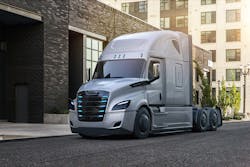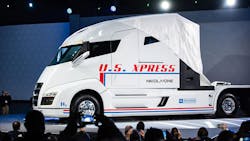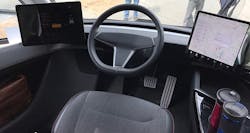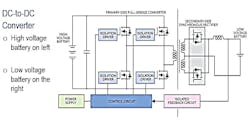If you're an old-timer like me, you know that what happens to the automotive industry in California, eventually finds its way to the rest of the country, especially when it comes to emissions. In late June, California announced that state regulators had approved new rules that would see a massive shift from conventional gas and diesel trucks and vans, to ones powered by batteries and hydrogen fuel cells, in an effort to address air pollution issues in the state.
In an article written by Cassandra Profita and published on NPR.org, Anthony Victoria, with the Center for Community Action and Environmental Justice says the communities that large commercial trucks are driving through in Southern California are living in a cloud of air pollution that he calls a "diesel death zone." Victoria's group has counted more than 1,000 diesel trucks an hour, passing through largely Latino neighborhoods.
"We're considered, in a lot of ways, America's shopping cart," Victoria says. "In our communities you have high asthma rates, high cancer rates, high diabetes rates, and that could all be attributed to the industry that exists here, the logistics industry."
Victoria says California's electric truck mandate could help save lives in these communities. The state estimates it could prevent 900 premature deaths, deliver $9 million in public health benefits, and remove 17 million metric tons of climate-warming carbon dioxide from the atmosphere.
The new regulations take effect in 2024 and govern a wide range of the commercial truck market, from medium duty up to Class 8 rigs. Guidelines already in place have addressed the state's desire to move the light duty segments (possibly, in part, explaining the move by GM and Ford to shift their focus from hybrid to EV with both scheduled to release all electric light trucks in the next few model years).
Under the new guidelines, at least 40 percent of the tractor-trailers sold in California would have to be powered by some form of zero emissions technology by 2024. On the medium duty side, 55 percent of all trucks sold would need to meet the zero emissions requirement by 2035, as will 75 percent of all delivery truck and vans sold in the state.
California’s push to reduce truck emissions could lead to some major changes in the automotive industry. Among other things, it could encourage the emergence of new competitors such as Nikola Motors, which is producing an array of hydrogen-powered heavy-duty trucks, and Detroit-based start-up Rivian, which has a contract to produce around 100,000 all-electric delivery vans for Amazon. That doesn't mean the domestic OEMs are taking a back seat, though.
General Motors recently announced plans to build electric delivery vans, in addition to the all-electric Hummer pickup to debut in 2021. The various subsidiaries of Daimler AG, such as Freightliner, have already launched an assortment of electric vans and heavy trucks, with more in the works. And Toyota is partnering with truck giant Kenworth, to develop hydrogen-powered Class 8 semi prototypes that could lead to production models later this decade.
What does this mean to you as shop owner and technician? The future, my friends, is getting closer to becoming the present. Are you prepared and trained to deal with the technologies?
New challenges for thermal management
The move to EV also creates challenges in keeping the occupants comfortable without impacting the range of the vehicle. In addition to cabin comfort, the battery assembly and related HV components also have to be kept cool.
In the March issue of SAE's publication, "Automotive Engineering", Paul Weissler shares insights gained from the SAE Thermal Management Systems Symposium. He writes that there are two major challenges engineers are working to overcome; heating the occupants in the winter and keeping the battery (and occupants) cool in the summer.
One solution is the use of a heat pump system, similar to what I've shared with you in the past and currently in use on the Nissan Leaf and Toyota Prius Plus. To put it simply, a heat pump is a conventional air conditioning system that is run in reverse to heat the cabin - turning the evaporator into a condenser and the condenser into an evaporator. The new system concepts, though, use liquid cooling for the battery pack rather than rely on the air cooling these two systems have. Other solutions being developed include a secondary loop system where the A/C system is used to chill a liquid coolant that is then used to cool down the battery pack and/or passenger area.
Another idea the OEMs are experimenting with is an improved, high tech version of the heated/cooled seat. By providing heat or cooling directly to the occupant, the demand on the cabin system can be reduced and that reduces battery loss and maintains range.
Want to know more? Join me at the Mobile Air Conditioning Society training event in February or visit https://www.sae.org/publications/magazines/content/20autp03/ to read Paul's article in its entirety.
Six months and counting
As I write this, it's been nearly six months since we all came to know about COVID-19. For many of us, life changed and brought us challenges unlike any we've ever seen, but as "essential workers", the majority of you still got up every morning and went to work to do what you do best - keeping America moving.
And you've shared with us how hard it's been. Business is still there, but for many of you, it's substantially less than what it was pre-coronavirus. Customer fears keep many away, but you adapted to do all you could to reassure them they, and their families, would not be at risk when doing business with your shop.
I just want to applaud you all for that, and thank you for the sacrifices you've made to keep your doors open. I hope and pray that, by the time you read this issue, those days will have passed, and we will be back on the path to normal, but if not, know that we at Motor Age, and all those in the Motor Age family (PTEN, ABRN), will be here to do what we can to provide you with the tools and resources you need to stay afloat.
Stay well.
